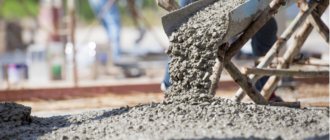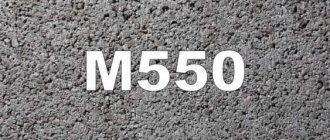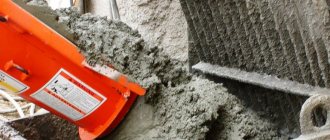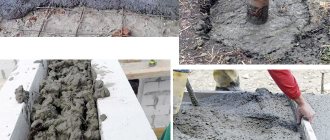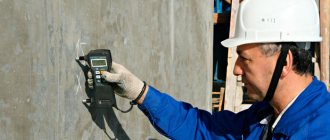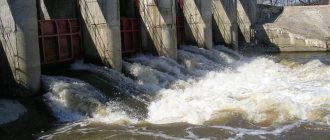Frost resistance of concrete is an important technical characteristic regulated by the requirements of the regulatory document GOST 26633-2012. The technical meaning of the frost resistance of heavy concrete is the ability of a concrete structure to withstand a certain number of freeze-thaw cycles without loss of strength and integrity.
In general, the numerical value of this value is determined by the grade of concrete and additives in concrete for frost resistance, which significantly increase the number of “freezing-thawing” cycles of a particular structure.
Concrete grades by frost resistance
The current regulatory document - GOST 26633-2012 “Heavy and fine-grained concrete”, defines building materials for the following frost resistance grades: F50, F75, and further up to F1000. In ordinary residential and commercial construction, frost resistance indicators range from F50 to F300, depending on the brand and class of the material used. For clarity, we present the following table of concrete frost resistance:
| Concrete grade according to GOST 26633-2012, “M” | Concrete class according to GOST 26633-2012 | Frost resistance of concrete according to GOST 26633-2012. |
| 100 | B7.5 | F50 |
| 150 | B10-B12.5 | F50 |
| 200 | B15 | F100 |
| 250 | IN 20 | F100 |
| 300 | B22.5 | F200 |
| 350 | B25 | F200 |
| 400 | B30 | F300 |
Note. Here and further in the text we will talk about heavy concrete, as the most common materials in low-rise, high-rise and commercial construction of buildings and structures.
As follows from the table of frost resistance of concrete, the stronger the material, the higher the frost resistance of concrete. Accordingly, if the developer is faced with the task of constructing the most durable building or structure, concrete material of the highest grades should be used.
Marking
The frost resistance requirements of concrete are determined taking into account climatic conditions (they will be different in Moscow and Novosibirsk), the depth of soil freezing, and the rate of change in ambient temperature.
Based on GOST 10060-2012, there are 5 classes of frost resistance:
- The low rating (F50) is only suitable for work inside warm rooms. A solution with this value is rarely used; under the influence of negative environmental factors, cracks will quickly appear on it.
- Normal resistance (F150) is suitable for the construction of buildings in areas where the climate is temperate or warm. Such buildings can serve without collapsing for 100 years.
- The increased rate (from F150 to F300) is intended for areas with harsh climate conditions and deep freezing of the soil (Siberia). The material is able to withstand sudden temperature changes and retains its performance characteristics for a long time.
- Frost-resistant concrete with an index of F300 to F500 can be used in northern regions where there is deep freezing of the soil and in areas where the water level may rise.
- A mixture with indicators F500-1000 has high stability and is used for the construction of the most critical facilities. High grades of concrete are used, into which special additives are introduced.
Marking is done after the concrete sample is immersed in water, kept for some time, then frozen to -18°C. Measurements are taken periodically to identify loss of strength.
Marking makes it easier to select concrete when performing construction work.
The frost resistance grade of concrete affects the choice of material class in the region. Before starting construction, you need to contact specialists and, with their help, choose the most suitable option.
How to increase the frost resistance of concrete
The issue of increasing the resistance of a material to low temperatures is very relevant for the harsh climate of most of the territory of the Russian Federation. At this point in time, there are two main ways to increase the frost resistance class of concrete:
- Increasing the density of concrete by reducing the volume of macropores and their permeability to moisture from atmospheric factors. For example, using the optimal “Water-Cement” ratio (approximately 0.5), thoroughly compacting concrete in various ways, using additives, using or clogging air formations by impregnation with special compounds, also by creating the most favorable conditions for setting and hardening of concrete ( covering with plastic wrap, regularly moistening with water by spraying and other measures).
- An increase in the reserve volume of air pores in the body of the structure (about 20% of the volume of freezing water), which are not filled with standard water saturation using special additives.
Popular additives for general use to increase the frost resistance of concrete: SNV resin air-entraining additive, Water repellent for concrete GKZh 136-41 (GKZh-94), Liquid 136-157M, Oil MH 15, TSF 484, SILRES BS and others.
Measures to increase frost resistance
Above, we discovered the relationship between the frost resistance of concrete and its composition and water absorption. This information will allow us to determine methods that will increase our indicator, and therefore will reduce or eliminate the risks of material destruction and increase its strength.
Here are some of them:
- using a material with a minimum number of pores (the fewer ways for water to penetrate, the better)
- elimination of pores after pouring the material by compaction by vibration
- the use of special additives in the composition (the most effective and reliable way to increase frost resistance even before work and without spending money on other operations)
Frost resistance of concrete is important not only in the construction of buildings; it plays a significant role in road construction and repair.
The use of high-quality concrete in these cases is not economically profitable, so the result is achieved by compaction (especially of the upper layers) and the use of additives in the mixture.
Testing concrete for frost resistance
Any developer of a private house and structure can test the resistance of his concrete structure to frost resistance in accordance with the requirements of GOST “Frost resistance of concrete 10060-2012”. To do this, you should contact one of the specialized companies. Determining frost resistance at home is almost impossible.
To create temperature conditions, a special freezer and other special equipment are required. Therefore, methods for determining the frost resistance of concrete are special methods that can be implemented in specialized companies equipped with special equipment and a staff of experienced personnel.
When contacting a specialized company, based on the results of frost resistance tests, an official document is drawn up - a Concrete Frost Resistance Protocol, which is provided to the customer.
Moreover, if the developer, when preparing concrete, observes the recommended proportions of concrete components of a particular brand, he can rely on the frost resistance data given in this table and not burden himself with expensive tests of samples for frost resistance.
Frost resistance of concrete of different grades: determination of how to increase it using additives
All materials used during construction and major repairs must comply with the climatic operating conditions. Last but not least, this concerns concrete, since the stability of the entire structure depends on its frost resistance and ability to withstand strong temperature changes.
Concrete is a porous material; when moisture from the soil or air gets into it, at negative temperatures it freezes and expands greatly, which leads to the appearance of cracks. The process can be repeated many times, and with each subsequent cycle the destruction will become more significant. Frost resistance of concrete is its ability to repeatedly withstand freezing and thawing, and at the same time retain its original physical and mechanical properties. The maximum permissible loss of strength is no more than 5%.
Concrete grades
The brand and class include such standards as quality, strength, water permeability and frost resistance. The last indicator directly depends on the structure of the material - the greater its porosity, the lower this parameter.
According to GOST 10060.0-95 standards in force in the Russian Federation, the frost resistance of concrete is indicated by the letter F and numbers indicating the permissible number of cycles of freezing and thawing of the solution during operation. Russian GOST standards are fully compatible with international standards.
| Frost resistance | Brand | Characteristics |
| Low | F50 or less | It is practically not used anywhere, since in the open air all structures with high water permeability are destroyed very quickly. |
| Moderate | F50-F200 | It has optimal performance and is the most common and widely used. It is this brand of concrete that is used for private construction in central Russia. |
| Increased | F200-F350 | This brand is intended for use of buildings in harsh climatic conditions. The material easily withstands significant temperature changes and retains its original qualities for decades. |
| High | F350-F500 | Required in exceptional cases, for example, in conditions of variable moisture. |
| Particularly high | F500 and more | It is used when the operational period is literally calculated in centuries. As a rule, such a high parameter is achieved by introducing various additives and additives. |
The grade and frost resistance class of concrete have a direct relationship - the greater the strength, the higher its price and the lower the water permeability. The ratios are shown in the table below:
| F | Brand | Class |
| 50 | B7.5-B12.5 | M100-M150 |
| 100 | B15-B22.5 | M200-M250 |
| 200 | B25 | M300-M350 |
| 300 | B30 | M400 |
| More than 300 | B35-B45 | M450-M600 |
How to increase frost resistance?
It directly depends on the number of macropores formed in the structure. As porosity decreases, resistance to multiple freeze-thaw cycles increases. There are several ways to increase frost resistance and reduce water permeability of cement mortar in private construction:
1. The first and most primitive method is to qualitatively compact the cement mixture when pouring. With strong compaction, the porosity of the material decreases significantly and the volume of moisture entering the concrete when it is saturated is reduced. For better compaction, it is advisable to use a high-power electric vibration compactor.
2. Increased frost resistance can be achieved by forming additional internal cavities. To do this, special air-entraining additives are mixed into the cement mortar to create small reserve pores, which can only be filled if water is applied to them under pressure.
3. And the last way is to add anti-freeze additives to the finished cement mixture. Such additives include urea, calcium salts, etc. When frozen, they form flaky ice, which is less destructive than regular ice.
Sometimes it is enough just to protect the concrete surface from direct contact with moisture. For this, special waterproofing materials and solutions are used, for example, bitumen or polymer mastic.
Application in construction
In private housing construction, ready-mixed concrete is most often used to pour the foundation for a building. Concrete for the foundation is selected taking into account the type of structure being constructed and local climatic conditions.
1. If the load on the base is small, for example, when building a frame-panel house or other country house, M200 concrete is best suited. For heavier objects, such as houses made of timber, foam blocks or bricks, you will need to purchase M250 or M300 cement mortar. For two-story heavy buildings, a monolithic foundation is most often poured - in this case, concrete grade no less than M350 is used.
2. You also need to pay attention to the characteristics of the soil and soil. For central Russia, M250 is suitable, but on clay and loamy soils, regardless of the type of building being constructed, only M350 and higher can be used for the foundation.
3. Class F for any brand of concrete is selected taking into account the climatic conditions of the region.
4. Concrete M300 B22.5 with class F150 or F200 is the most common and used in private construction. This brand is well suited not only for pouring the foundation, but also for the production of a monolithic slab, the manufacture of a pool bowl and a load-bearing floor.
Similar articles
- How much does a cube of concrete cost: in a mixer with and without delivery, prices of different brands? It’s hard to imagine building even a small country house without concrete work. And if the construction also requires a strong foundation, then cubes...
- Concrete porch: how to make it yourself, proportions of concrete mixture, finishing options
Making a concrete porch with your own hands is not difficult. But first you need to think through all the details so that when you enter the house, you don’t stumble over uncomfortable steps, but... - Do-it-yourself concrete vibrator (site and deep): diagram, step-by-step instructions, drawings
To compact, and therefore strengthen the structure of concrete, you need to use a special tool - a vibrator. With its help, it’s easy to kick out…
Concrete with antifreeze additive. PMD for concrete. Winter concrete
There are several methods by which you can determine how frost-resistant ready-made concrete is. The presence of cracks in the concrete, its peeling and the presence of stains indicates a decrease in the strength of the concrete. It is possible to quickly test concrete for frost resistance; to do this, it must be placed several times in sodium sulfate and dried at a temperature of more than 100 ° C; if no signs of destruction appear on the test sample, then such concrete is resistant to frost.
Frost resistance is also achieved through the use of special additives. There are two types of additives that increase thermal stability. The first includes additives that make it possible to increase the density of the concrete structure as a result of slowing down its setting. Due to increased sedimentation. The second group includes additives that promote the formation of spherical air pores. As a result, an air cushion effect is achieved and the thermal insulation properties of concrete increase, respectively, and its susceptibility to temperature changes. At the same time, the use of antifreeze additives allows concrete work to be carried out at temperatures down to -15 °C.
What is frost resistance of concrete
Frost resistance of concrete is the ability of concrete to maintain strength during alternating freezing and thawing.
This value is indicated by the letter F with a number. The number, in this case, is the number of cycles from -20 to +20 and back that the sample must withstand without reducing its basic characteristics compared to a control sample of equivalent age. You should not expect that if F = 75, then concrete will withstand 75 winters without loss of strength, because in one season there can be several jumps from “plus” temperatures to “minus” and back. Especially in St. Petersburg, where the weather is completely unpredictable.
Frost resistance does not in any way affect the ability of concrete to set in the cold. Antifreeze additives are responsible for this, which temporarily prevent water from freezing at temperatures below 0, for example Cemaktiv-3.
Frost resistance of concrete depending on its class and brand
The builders made f50 and say that this is enough. To the SP’s references that for alternating temperatures f75 is the minimum, they answer that there won’t be such temperatures here, that it’s inside and all that. The building is not heated. Are they right? Takeshiz View profile Find more posts by Takeshiz. In terms of frost resistance, Portland slag cements occupy an intermediate position between Portland and pozzolanic cements.
Such ultra-thin cements are characterized by increased shrinkage, leading to the appearance of microcracks. Strict requirements are imposed on limiting the amount of loss on ignition caused by the staleness of cement. Storage of cement has a much greater effect on the frost resistance of concrete than on activity.
The climate in our region is characterized by long winters, low temperatures, precipitation and a highly frozen soil layer. Those materials that are used in the repair and construction industry have non-standard characteristics, including frost resistance. Frost resistance of concrete is a quality that is determined by the ability to withstand aggressive weather conditions, temperature changes, freezing and thawing of the concrete mixture, which affects such properties as strength. The frost resistance of concrete is marked with the letter F, as an indicator that the concrete will withstand even maximum temperatures. The advantage of such concrete is that it does not change in its shape over time, does not crumble, adapts to any weather conditions, and tolerates areas with high humidity.
According to S. Shestoperov, the presence of a shell of new formations of hydrated minerals on cement grains is one of the main reasons for the reduction in the durability of concrete. Usually used to produce heavy concrete, quartz sand and crushed stone from dense igneous or metamorphic rocks that meet the requirements of the standards make it possible to obtain highly frost-resistant concrete.
The frost resistance of concrete is significantly influenced by the frost resistance of the aggregates themselves and their water demand. According to S.
